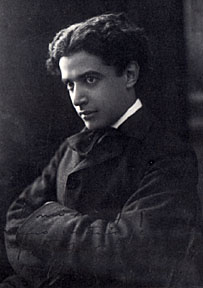Home | 1 • 2 • 3 • 4 • Next Page |
|||
|
|||
Home | 1 • 2 • 3 • 4 • Next Page |
Home | 1 • 2 • 3 • 4 • Next Page
While living in France from 1925 to 1932, Manuel Maria Ponce (1882-1948) composed pastiches of Baroque, Classical and Romantic music at the request of guitarist Andrés Segovia (1893-1987). Ponce's emulation of the Baroque style was convincing and many people believed these pieces to be authentic 18th century works. Nevertheless, a knowledgeable listener may glimpse Ponce's personality in the romantically tinged lyricism and stylized Baroque mannerisms. Two non-Baroque pastiches, Sonata clasica and Sonata romántica, were later published by Schott in Segovia editions. However, the Baroque pastiches, written under various 18th century pseudonyms, were intended for Segovia's personal use and were not officially released for publication.
Manuel Maria Ponce (1882-1948)

Ponce's numerous Baroque pastiches for orchestra, keyboards and guitar aptly illustrate his fascination with the music of the 18th century. Moreover, neoclassical influences are evident in his works in general: 18th century formal structures such as the variation form, sonata form, rondo form, suite and fugue are common in his works of the 1920s and 1930s. By 1940, these neoclassical leanings developed into an austere and modernistic style of neoclassicism akin to that of Carlos Chávez and his disciples. Unfortunately, Ponce composed very little for the guitar during these final years of his life.
Carlos Vázquez, a pupil of Ponce, concert pianist and heir to the Ponce estate,1 was cited in a newspaper article concerning the Ponce pastiches:
. . . Segovia, faced with a lack of original compositions for guitar, asked Ponce to write baroque and classical music for him. Segovia, however, did not want to fill his concerts with compositions by only one man—Ponce—so the two agreed to attribute many of them to other composers according to Vázquez. Vázquez explained that when visited Segovia in 1964 in Madrid the guitarist promised to give Ponce credit for the compositions in his memoirs, but gave him permission to announce what he called their "joke" earlier in México. 2
Ponce's total output for guitar only amounts to 28 compositions.3 Certainly such a small number of works, most of which are not pastiches, could not have filled Segovia's concerts. Although Segovia frequently performed Ponce's pastiches during the 1920s and 1930s, transcriptions of composers such as Bach, Scarlatti, Rameau, etc., were more prominent. It is likely that Segovia's programming of pastiches was due to the influence of Fritz Kreisler,4 not due to a lack of repertoire. Perhaps Segovia wanted to see if he could fool the critics too.
The authorship of Ponce's pastiches was known to many guitarists prior to Carlos Várzquez's announcement of the "joke" in 1964. The popularity of these works eventually prompted certain editors into piracy and, via transcriptions of Segovia recordings, some pastiches were published under their alleged composers. Amazingly, these editors boldly labeled their editions as transcriptions of 18th century lute tablature.
Segovia's Kreisleresque jokes are to blame for the confusion surrounding Ponce's pastiches. Fortunately, Segovia, in his later years, has helped to dissipate some of the confusion by recording the Preludio under Ponce's name (RCA ARLi-0864, 1975), and by allowing his manuscript of the Suite en la mineur (Paris: Éditions Musicales Transatlantiques, 1983) to be published as a Ponce original.
Although most performers today credit these pastiches to their rightful composer, some of the published editions are still sold under pseudonyms. To make matters worst, a counterfeit Ponce pastiche, Giga melancolica, exists in a Columbia edition edited by Sophocles (Two Pieces, CO-199). This beautiful piece is actually a transcription of the Gigue from Suite Two for Harpsichord by Jacob Froberger (1616-1667). Thus, the location of these works for the uninformed can prove frustrating.
The remaining pages of this article consist of an examination of Ponce's published Baroque pastiches for guitar solo.
Footnotes
1Carlos Vázquez maintains Ponce's house in Aguascalientes, México (La Acordada No. 47, Col. San José Insurgentes) as a private collection of Ponce's manuscripts, writings and other memorabilia.
2"Much of Segovia Music Termed Mexican's Work," Stamford Advocate, 30 June 1971. Incidentally, Segovia's memoirs are still forthcoming.
3Only original guitar solos, chamber music with guitar, and his guitar concerto are included for this tally. Segovia's statement that Ponce "composed more than eighty works for the guitar" (Guitar Review, No. 7 [1948], p. 3) is either erroneous or implies the existence of undiscovered works. Even when one counts the individual movements of sonatas, variations, and character piece sets as separate works, the tally still only comes to 60.
4Fritz Kreisler (1875-1962), a renowned Austrian violinist, composed and performed pastiches under 18th century pseudonyms such as Vivaldi and Corelli during the early 20th century. In 1935, he declared himself the composer of these works and, thus, the ensuing controversy gained him much attention.
©Copyright 2000-2024 by Peter Kun Frary | All Rights Reserved
Home | 1 • 2 • 3 • 4 • Next Page